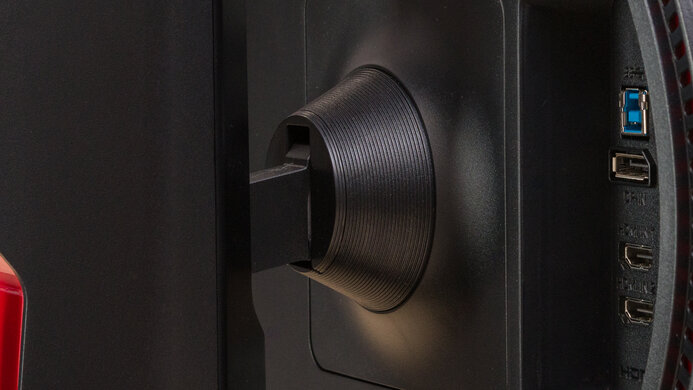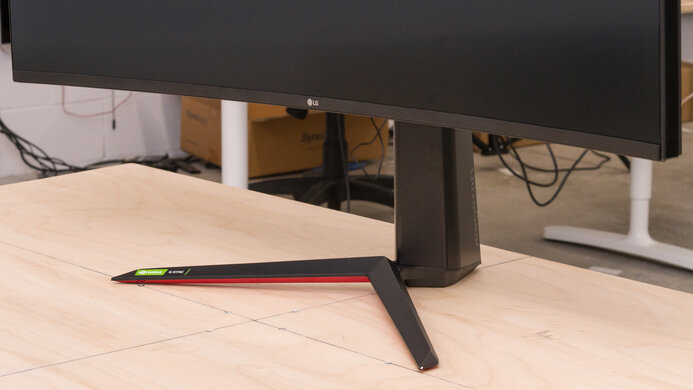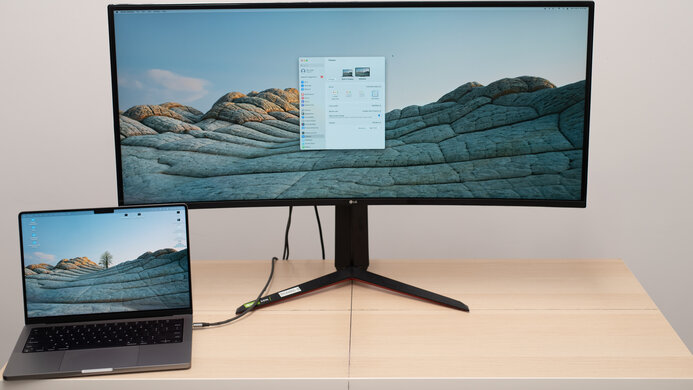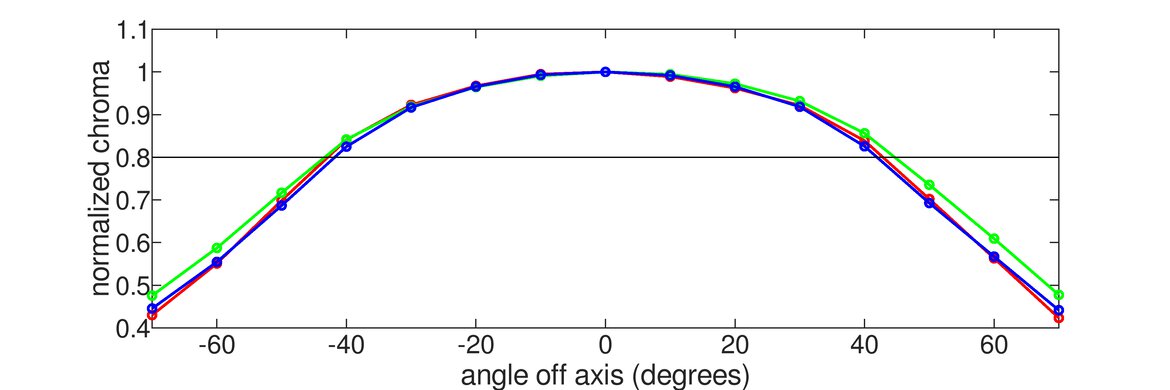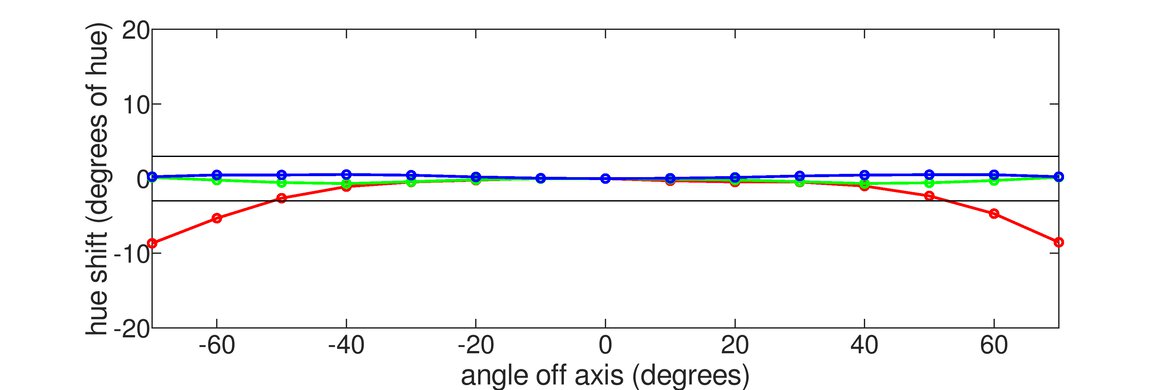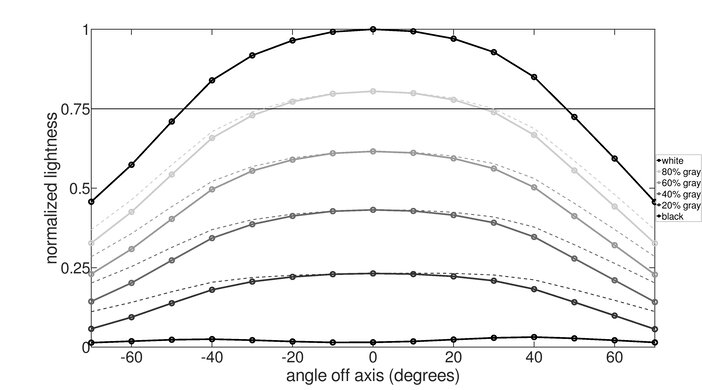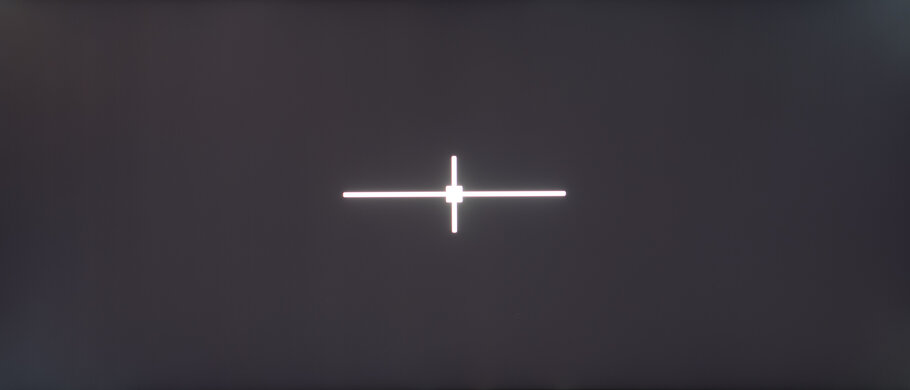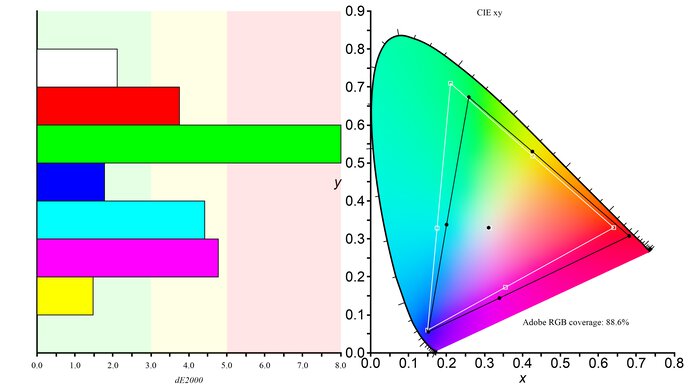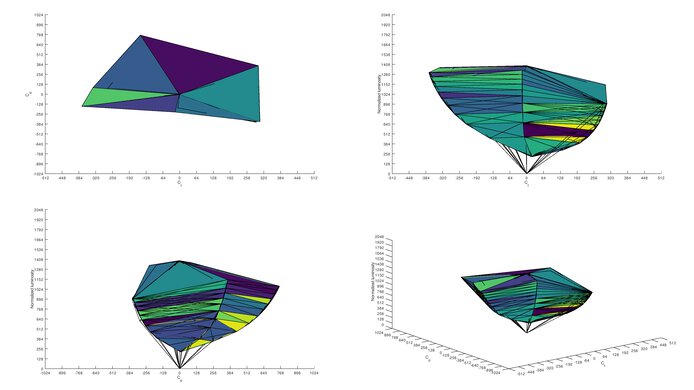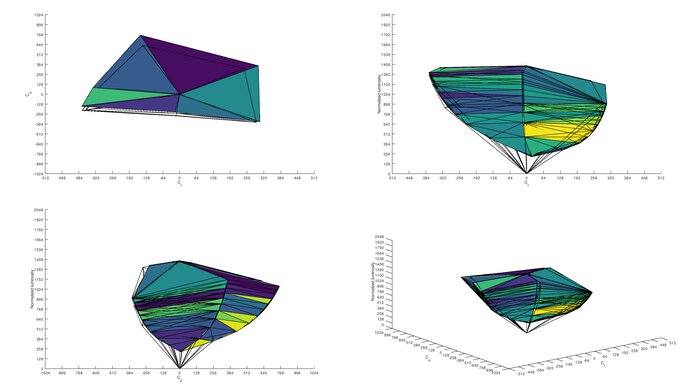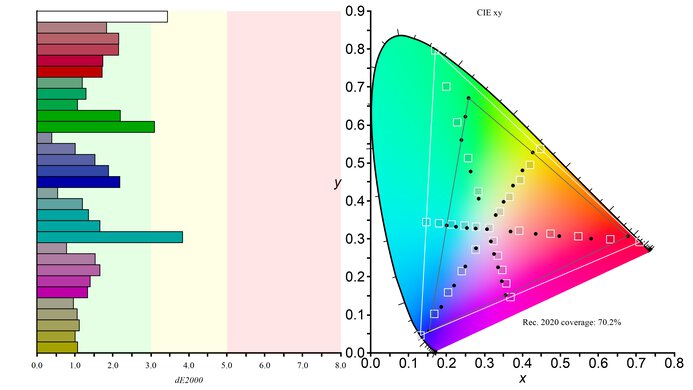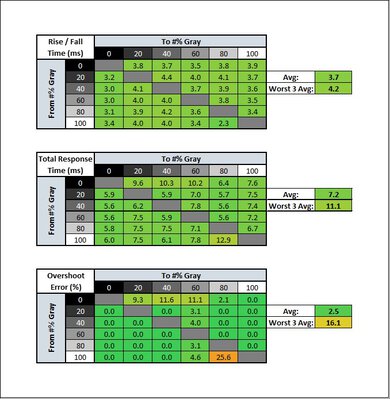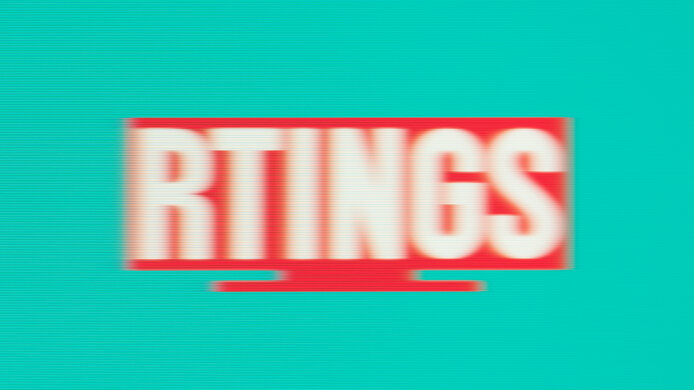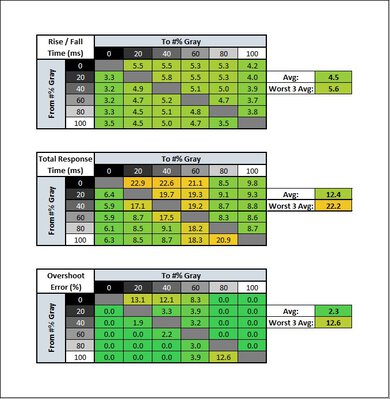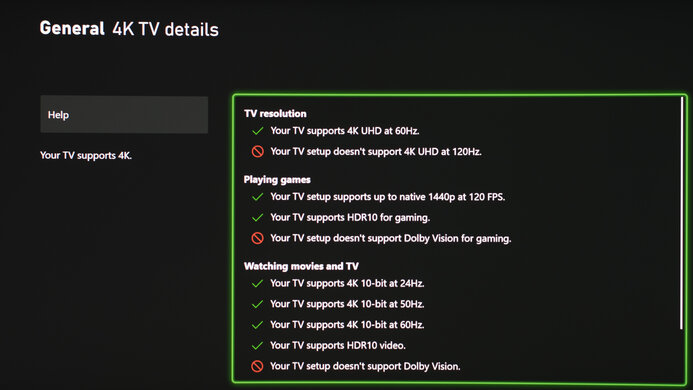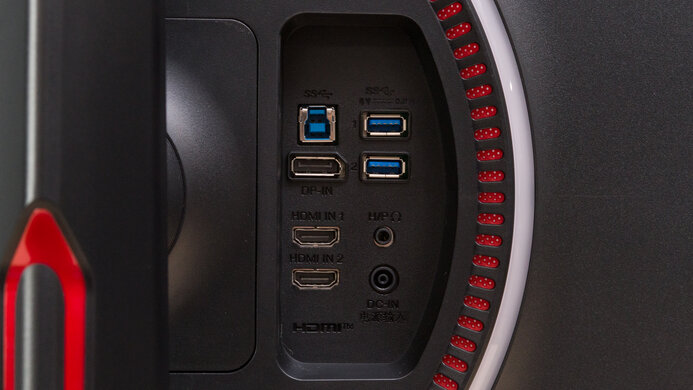The LG 38GN950-B is a great ultrawide gaming monitor. It's the successor to the LG 38GL950G-B, but unlike its predecessor, it supports FreeSync natively instead of G-SYNC. It's certified as G-SYNC compatible, though, so those with an NVIDIA graphics card still get a nearly tear-free gaming experience. It has low input lag, exceptional response time, and a 144Hz refresh that you can overclock up to 160Hz, resulting in amazingly fluid gameplay. Its 38 inch high-resolution screen provides incredible immersion and tons of space for multitasking, making it a good choice for work and media consumption. It has a great wide color gamut and impressive peak brightness to deliver a pretty good HDR experience, although it's not the best option for dark room viewing due to its sub-par contrast. Unfortunately, the stand doesn't allow for any swivel adjustment.
Our Verdict
The LG UltraGear 38GN950-B is a great monitor overall. It's great for gaming as it has a high refresh rate, exceptional response time, and VRR support, resulting in smooth and responsive gameplay. Its large, high-resolution screen feels immersive and provides plenty of space for multitasking, making it a good option for media consumption and productivity. Although its contrast is sub-par and its local dimming is terrible, it has a great color gamut and high peak brightness to deliver a good HDR experience. Its viewing angles are good enough for sharing content casually or playing co-op games, but there's still some loss of image accuracy that might be a dealbreaker for content creators.
- Large high-resolution screen.
- Good viewing angles.
- Gets bright enough to fight glare.
- Good text clarity.
- May struggle with bright reflections.
- No swivel adjustment.
The LG 38GN950-B is good for office use. It has a large 38 inch ultrawide screen that gives you plenty of space to open multiple windows side-by-side, and its high pixel density results in sharp images and text. Its reflection handling is just okay, but the screen gets pretty bright, so you shouldn't have any visibility issue in most settings. The stand doesn't swivel at all, which isn't ideal if you need to turn the screen to share your work with a coworker. On the upside, it has good viewing angles, so the image remains accurate at the sides when you sit up close and when viewing from the side.
- Large high-resolution screen.
- Good viewing angles.
- Gets bright enough to fight glare.
- Good text clarity.
- May struggle with bright reflections.
- No swivel adjustment.
The LG 38GN950-B is a great gaming monitor. It delivers an immersive gaming experience thanks to its large screen and high resolution. It has low input lag, a 160Hz refresh rate, and exceptional response time, delivering smooth and responsive gameplay. It supports FreeSync and is certified as G-SYNC compatible to reduce screen tearing. Unfortunately, it's not the best for gaming in the dark because it has a sub-par contrast ratio, and its terrible local dimming doesn't improve black level at all.
- 160Hz refresh rate.
- Exceptional response time.
- Large high-resolution screen.
- VRR support.
- Sub-par contrast.
- Terrible edge-lit local dimming.
The LG 38GN950-B is good for media consumption. It has a large, high-resolution screen that feels incredibly immersive. It doesn't handle reflections all that well, but it gets bright enough to combat glare in most lighting conditions. The viewing angles are good, so the image remains fairly accurate when viewed from the side, great for sharing content with others. Sadly, the ergonomics are somewhat limited because it doesn't swivel at all, and its sub-par contrast ratio isn't ideal for dark rooms.
- Large high-resolution screen.
- Good viewing angles.
- Gets bright enough to fight glare.
- Full sRGB coverage.
- Sub-par contrast.
- May struggle with bright reflections.
- Terrible edge-lit local dimming.
- No swivel adjustment.
The LG 38GN950-B is great for content creation. Its 38 inch ultrawide format is amazing for video editors working on a timeline, and its high pixel density lets you see all the fine details of your work clearly. It has full sRGB coverage, superb gradient handling, and no color bleed. The stand doesn't allow for swivel adjustment, which makes it harder to turn the screen when you need to show your work to clients and colleagues. On the upside, the viewing angles are good, so the image remains accurate when viewed from the side.
- Large high-resolution screen.
- Good viewing angles.
- Gets bright enough to fight glare.
- Full sRGB coverage.
- May struggle with bright reflections.
- No swivel adjustment.
The LG 38GN950-B is decent for HDR. It displays a wide range of colors and gets bright enough to make them look vivid and for highlights to stand out. However, it has a low contrast ratio that makes blacks look gray in the dark and has a terrible local dimming feature that doesn't improve the dark scene performance.
- Outstanding DCI-P3 coverage.
- Great HDR peak brightness.
- Sub-par contrast.
- Terrible edge-lit local dimming.
Changelog
- Updated Feb 28, 2023: Clarified in the Variants section that the LG 38GN95B-B is the same monitor but it's sold at other retailers and has a different stand.
- Updated Feb 09, 2023: Added text in the macOS Compatibility and Console Compatibility boxes and clarified text throughout as part of Test Bench 1.2.
- Updated Feb 08, 2023: Updated to Test Bench 1.2, resulting in changes to the results and scores with the Response Time and Input Lag. Added tests for Console Compatibility and macOS compatibility and made minor changes to other tests, which you can see in our Changelog.
- Updated Oct 11, 2022: We rechecked for Picture-in-Picture support and found that it doesn't actually support PIP or PBP (Picture-by-Picture). We've updated the Additional Features section of the review.
Check Price
Differences Between Sizes And Variants
We tested the 38-inch LG UltraGear 38GN950-B, and the LG 38GN95B-B is the same monitor with a slightly different stand that's sold at other retailers. It replaces the LG 38GL950G-B, and you can see the differences below.
| Model | Size | Resolution | Max Refresh Rate | VRR | Cable Management | Notes |
|---|---|---|---|---|---|---|
| 38GN950-B | 38" | 3840x1600 | 160Hz | FreeSync | Yes | DisplayHDR 600 |
| 38GN95B-B | 38" | 3840x1600 | 160Hz | FreeSync | No | DisplayHDR 600 |
| 38GL950G-B | 38" | 3840x1600 | 175Hz | G-SYNC | No | DisplayHDR 400 |
Our unit was manufactured in December 2020; you can see the label here.
Popular Monitor Comparisons
The LG UltraGear 38GN950-B is a great gaming monitor. However, it's much more expensive than the LG 34GN850-B without providing a significantly better gaming experience. That said, it might be worth it if you want to game in HDR because it has a wider color gamut and gets a lot brighter. For more options, check out our recommendations for the best ultrawide gaming monitors, the best curved monitors, and the best gaming monitors.
The LG 38GN950-B is the successor to the LG 38GL950G-B. However, there's one key difference: the 38GN950-B has native FreeSync support instead of G-SYNC like its predecessor. That said, it's still certified as G-SYNC compatible. The other big change is that the 38GN950-B only overclocks up to 160Hz instead of 175Hz, although most people shouldn't feel any difference. The 38GN950-B has a wider color gamut and much higher peak brightness to deliver a better HDR experience. It has local dimming, which the 38GL950G-B lacks, but it performs terribly.
Although the LG 38GN950-B and the LG 38WN95C-W are very different in their outer design, they're actually quite similar. The main difference is that the 38GN950-B's 144Hz refresh rate can be overclocked up to 160Hz. The 38GN950-B has a better HDR color gamut and volume, and it gets a bit brighter overall. The 38WN95C-W has a few more features, like a USB-C port with Thunderbolt 3 support and built-in speakers.
The LG 38GN950-B and the Dell Alienware AW3821DW are very similar overall. They're both 38 inch, 21:9 IPS monitors with a 3840 x 1600 resolution. The LG is a native FreeSync model with G-SYNC compatibility, while the Dell is a native G-SYNC model with FreeSync compatibility. The LG's refresh rate can be overclocked up to 160Hz, whereas the Dell is capped at 144Hz, and it has better response times than the Dell. The LG also has a better color gamut and higher peak brightness, resulting in a better HDR experience. The LG has wider viewing angles for sharing content or playing co-op games, but its ergonomics aren't as good as the Dell's because it doesn't swivel at all.
The LG 38GN950-B and the LG 34GN850-B are very similar in design and performance. The 38GN950 has a bigger screen and a higher resolution, although the pixel density is the same. It also has a much wider color gamut and gets a lot brighter, which means it can deliver a much better HDR experience than the 34GN850-B.

We buy and test more than 30 monitors each year, with units that we buy completely on our own, without any cherry-picked units or samples. We put a lot into each unbiased, straight-to-the-point review, and there's a whole process from purchasing to publishing, involving multiple teams and people. We do more than just use the monitor for a week; we use specialized and custom tools to measure various aspects with objective data-based results. We also consider multiple factors before making any recommendations, including the monitor's cost, its performance against the competition, and whether or not it's easy to find.
Test Results

The LG 38GN950-B is very similar in design to its predecessor, the LG 38GL950G-B. Like other 2020 UltraGear monitors, the stand has been redesigned slightly. The column is wider at the bottom, and the wide V-shaped feet are elevated so that they only make contact with the table at the tips. There are still some red accents and RGB lighting on the back.
The LG 38GN850's build quality is decent. The all-plastic construction feels basic but solid, and there are no obvious gaps or loose parts. There's a bit of flex around the RGB lighting, although it's not bad enough to be of concern. The stand supports the monitor well, and there's very little wobble. Unfortunately, the cable management cutout on the stand feels pretty flimsy.
The LG 38GN950 has disappointing ergonomics. It doesn't swivel, and the tilt range is pretty narrow.
The back is similar to the LG 38GL950G-B, except that the LG branding has been replaced with the UltraGear logo. You can control the RGB lighting strip through software or with the wheel at the bottom of the screen. The small cutout in the stand is for cable management.
Like most IPS panels, the LG 38GN950 has a sub-par contrast ratio, which makes blacks appear gray when viewed in the dark. It's slightly below the advertised 1000:1; however, contrast may vary between individual units. The local dimming doesn't improve the contrast at all because our test pattern triggers all the local dimming zones. We measured a part of the screen that wasn't lit during our local dimming test and got a 5634:1 contrast. However, this rarely happens in real content because all the zones are on most of the time.
The LG UltraGear 38GN950 has a terrible local dimming feature. It's edge-lit, and the dimming zones are huge. It doesn't do much in most content because all the zones light up even when there's just a tiny object on the screen. Subtitles and small stars also make the entire screen light up. Zone transitions are very visible, but again, it rarely happens that a zone is off when displaying real content.
The LG 38GN950 has excellent SDR peak brightness. It's very consistent across different content and more than bright enough to overcome glare, even in well-lit, sunny rooms.
We measured the SDR peak brightness after calibration in the 'Gamer 1' Game Mode (picture mode) with Brightness set to max.
The LG 38GN950 has impressive HDR peak brightness. It gets bright enough to make highlights stand out, but some larger highlights dim over time. It follows the target PQ curve fairly well until there's a sharp roll-off at the peak brightness, resulting in a loss of fine details with bright scenes. These results are in the 'Gamer 1' Game Mode.
The LG 38GN950 has good horizontal viewing angles, similar to the LG 38GL950G-B. Although our black level results are very different between the left and right side, the difference is actually very minor because the left side stays below our 3% threshold while the right is only slightly above. Overall, you shouldn't see much loss in image accuracy when viewing from the side.
The LG 38GN950 has decent horizontal viewing angles. The image looks dimmer and washed-out when viewing from above or below.
Black uniformity is okay. The whole screen looks gray, and there's visible backlight bleed at the top corners. There's no difference between having local dimming enabled or disabled because our test pattern seems to trigger all the local dimming zones. This picture from our local dimming video shows the difference between the zones that are on and the ones that are off. Note that black uniformity varies between units.
The LG 38GN950-B has excellent accuracy before calibration. It has an sRGB mode that locks the colors to the sRGB color space, meaning they don't look oversaturated. The white balance and color temperature are both fantastic, and gamma follows the target curve well, but dark scenes are too dark, while bright scenes are too bright. However, using the sRGB mode locks most picture settings, like the Response Time and Black Stabilizer settings, and you can't even use VRR. In that case, the 'Gamer 1' mode is the most accurate most, but colors are oversaturated in sRGB.
Accuracy is superb after calibration. The remaining inaccuracies aren't visible to the naked eye.
The LG 38GN950 has an excellent HDR color gamut. It has fantastic coverage of the DCI-P3 color space used in most HDR content, and the tone mapping is incredible. However, its coverage of the wider Rec. 2020 is much more limited.
The LG 38GN950's reflection handling is just okay. It should be fine for most lighting conditions, but it may struggle with direct sunlight. That said, the screen gets bright enough to compensate, so you shouldn't have visibility issues in most instances.
The LG 38GN950 has a 144Hz refresh rate that you can overclock up to 160Hz to make motion appear smoother. Enabling Overclock also turns on Adaptive Sync. You need a DisplayPort connection to use the overclock as the max refresh rate is limited over HDMI due to bandwidth limitations.
FreeSync works over both DisplayPort and HDMI connections, while G-SYNC only works over DisplayPort.
| Overdrive Setting | Response Time Chart | Response Time Tables | Motion Blur Photo |
| Off | Chart | Table | Photo |
| Normal | Chart | Table | Photo |
| Fast | Chart | Table | Photo |
| Faster | Chart | Table | Photo |
The LG 38GN950-B has an amazing response time at its max refresh rate, resulting in clear motion with only a short blur trail behind fast-moving objects. The best overdrive setting is 'Fast' because it has the quickest response time while keeping overshoot at an acceptable level.
| Overdrive Setting | Response Time Chart | Response Time Tables | Motion Blur Photo |
| Off | Chart | Table | Photo |
| Normal | Chart | Table | Photo |
| Fast | Chart | Table | Photo |
| Faster | Chart | Table | Photo |
The response time at 120Hz is excellent. Motion looks smooth, but unlike at the max refresh rate, the recommended overdrive setting is 'Normal' because 'Fast' has a slower total response time with more overshoot. This means you may have to change the setting if the frame rate of your game drops.
| Overdrive Setting | Response Time Chart | Response Time Tables | Motion Blur Photo |
| Off | Chart | Table | Photo |
| Normal | Chart | Table | Photo |
| Fast | Chart | Table | Photo |
| Faster | Chart | Table | Photo |
The response time at 60Hz is good. There's a bit more motion blur than with faster refresh rates, but it's still minimal. Once again, the recommended overdrive setting is 'Normal' because there's more overshoot with 'Fast' and 'Faster'.
The LG 38GN950 doesn't have a Black Frame Insertion feature.
The LG 38GN950-B has exceptionally low input lag for a responsive feel while gaming.
The LG 38GN950 has a large 21:9 screen that delivers an immersive gaming experience. It gives you more horizontal screen space than a standard 16:9 display, increasing your field of view in games and allowing you to place multiple windows side-by-side. That said, not all games support an ultrawide format, so you may see black bars at the sides, or the image might be stretched to fill the screen. While its resolution may seem odd, the pixel density is roughly the same as a 34 inch, 3440 x 1440 display.
The LG 38GN950-B works well with the PS5, but without HDMI 2.1 bandwidth, it doesn't support 4k @ 120Hz or VRR. It downscales a 4k image, which results in a sharper image than a native 1440p signal. However, the PS5 doesn't support ultrawide gaming, so you'll see black bars on the sides.
The LG 38GN950-B works well with the Xbox Series X. It downscales a 4k image, which results in a sharper image than a native 1440p signal. It supports 1440p @ 60Hz only with the console's HDMI override settings, which disables VRR. The Xbox doesn't support ultrawide gaming, so you'll see black bars on the sides.
The LG 38GN950-B works well with macOS devices, but there are a few issues. You can't change the resolution as it's limited to 3840x1600, and using the overclock feature limits the refresh rate to 75Hz. If you disable the overclock, it can reach 144Hz, and VRR works without issues. If you're using a MacBook, it continues working on the monitor even with the lid closed, and windows stay in place even when opening the lid.
The LG 38GN950-B has a few extra features, including:
- Crosshair: Adds a virtual crosshair on the screen.
- Black Stabilizer: Makes objects more visible in dark scenes.
- Reader Mode: Blue light filter to help reduce eye strain.
- RGB bias lighting: RGB lighting on the back of the monitor. You can control this using the physical wheel on the monitor or through LG's UltraGear Control Center software.



